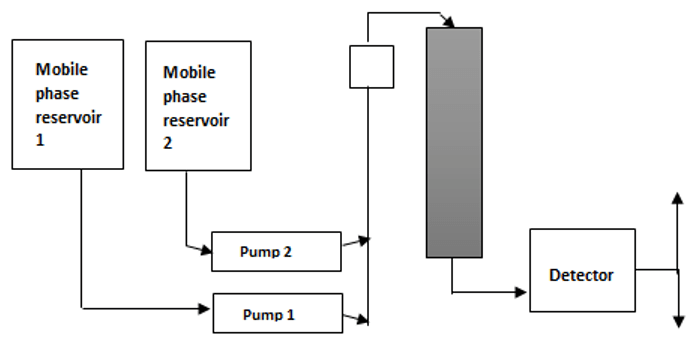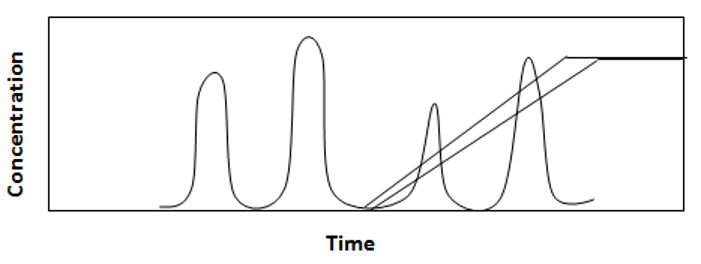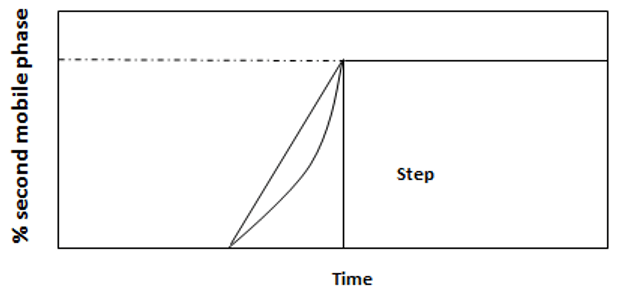This set of Bioseparation Science Multiple Choice Questions & Answers (MCQs) focuses on “Binary Chromatography”.
1. The use of single mobile phase for the chromatographic separations is known as ____________
a) Isocratic separation
b) Hydrophobic chromatography
c) Size exclusion chromatography
d) Binary chromatography
View Answer
Explanation: The theory and methods of chromatographic separation that includes use of single mobile phase for the chromatographic separations is isocratic chromatography. The term is given based on based on manner of carrying out chromatographic separation.
2. Which mode of separation is used in Size exclusion chromatography?
a) Binary mode
b) Isocratic mode
c) Reverse phase
d) Ion exchange
View Answer
Explanation: The separation of solutes in size exclusion chromatography is based on use of single mobile phase therefore, it is separated through isocratic mode of separation.
3. The use of double mobile phase for the chromatographic separations is known as _________
a) Isocratic separation
b) Hydrophobic chromatography
c) Size exclusion chromatography
d) Binary chromatography
View Answer
Explanation: The use of double mobile phase for the chromatographic separations is known as binary chromatography, the manner of carrying out chromatographic separation is using more than one mobile phases.
4. What is the significance of given diagram?

a) Isocratic separation
b) Binary chromatography
c) Hydrophobic chromatography
d) Size exclusion chromatography
View Answer
Explanation: The given diagram shows the use of two mobile phase as well as two pumps for the process of chromatographic separation, therefore it is the set-up of binary chromatography.
5. The initial mobile phase in the binary chromatography promotes __________
a) interaction
b) weak interaction
c) strong interaction
d) very weak interaction
View Answer
Explanation: The use of initial mobile phase in chromatographic separation promotes strong interactions between the stationary phase and the solutes that needs to be retained in the column and the unbound solutes are removed from the column.
6. The flow of solutes switch over takes place in the second mobile phase to __________
a) release bound solutes
b) elute bound solutes
c) release or elute bound solutes
d) conserve the bound solute
View Answer
Explanation: The binary chromatography separation involves the use an initial mobile phase for the promotion of strong interactions between the stationary phase and the solutes which needs to be retained in the column and then the weakly interacting solutes are removed from the column then the mobile phase switch over takes place to a second mobile phase release or elute the bound solutes.
7. The choice of second mobile phase is based on the __________
a) bound solutes
b) unbound solutes
c) eluted solutes
d) released solutes
View Answer
Explanation: The selection of second mobile phase in binary chromatography is based on the presence of the bound solutes that cannot continue interaction with the stationary phase and then are released from the column.
8. The order of bound solutes to the effluents depends on __________
a) nature of interaction, solutes interaction
b) properties of first mobile phase, properties of second mobile phase
c) manner of mobile phase change, manner of mobile phase selection
d) nature of interaction, properties of first mobile phase, manner of change of mobile phase
View Answer
Explanation: The order of bound solutes to the effluents depends on the nature of the interactions between the stationary phase and the solutes, second mobile phase properties and the manner of change of mobile phase are the major parameters for the bound solutes to appear in the effluents.
9. What is the significance of the given diagram?

a) Chromatogram obtained from binary chromatography
b) Chromatogram obtained from isocratic chromatography
c) Chromatogram obtained from the size exclusion chromatography
d) Chromatogram obtained from the HPLC
View Answer
Explanation: The given diagram explains the chromatogram of binary chromatography in which a mixture of four solutes are observed out of that, solute A is non-interacting, solute B is weakly interacting, solute C is strongly interacting, and solute D is very strongly interacting. Solute A appears in the effluent at the same retention time as the retention time of mobile phase and is followed by the weakly interacting solute B. C and D.
10. The thumb rule of selection of mobile phases is based on the separation mechanisms of __________
a) ion-exchange, affinity
b) affinity, ion-exchange
c) reverse phase, affinity
d) hydrodynamic interaction, reverse phase, affinity, ion-exchange
View Answer
Explanation: The thumb rule of selection of mobile phases is based on the separation mechanisms of various separation including ion-exchange which have low ionic strength first mobile phase and high ionic strength second mobile phase; affinity which have physiological conditions first mobile phase and acidic pH second mobile phase; reverse phase which have polar first mobile phase and non-polar second mobile phase; hydrophobic interaction which have high concentration of anti-chaotropic salt first mobile phase and anti-chaotropic salt free second mobile phase.
11. What is the significance of the given diagram?

a) Changeover of stationary phase in binary chromatography
b) Changeover of mobile phase in binary chromatography
c) Changeover of stationary phase in isocratic chromatography
d) Changeover of mobile phase in isocratic chromatography
View Answer
Explanation: The changeover of mobile phase can be obtained through change in step, change in the gradient may be linear or non-linear.
Sanfoundry Global Education & Learning Series – Bioseparation Science.
To practice all areas of Bioseparation Science, here is complete set of 1000+ Multiple Choice Questions and Answers.
If you find a mistake in question / option / answer, kindly take a screenshot and email to [email protected]
